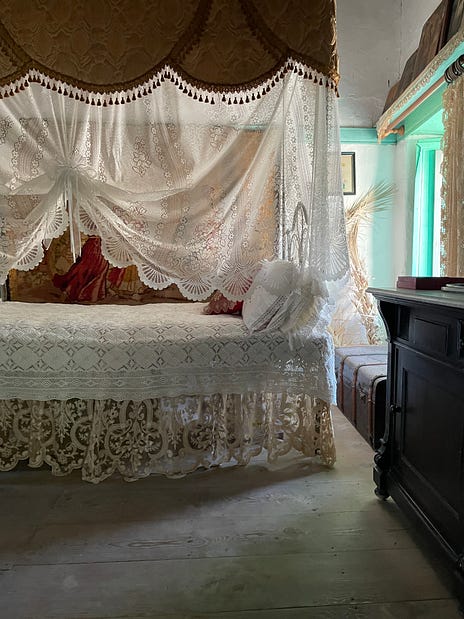Savour - lace
This is savour: notes on the delicious things in life, delivered every Wednesday. Thank you for being a free member! If you enjoy getting these emails or find yourself telling your pals about them, you may want to consider upgrading your subscription. For £3.50 a month, you’ll receive savourites, my Friday dispatch of notes from the week, along with recommendations of things to read, eat and generally indulge in, and support my work more meaningfully. I was the last visitor of the day; the museum closed in 10 minutes. We’d only intended to have a wander around the Chora: no monasteries, no windmills, no caves of the apocalypse for us. Instead, a doorway that opened onto two neighbours having a chat, painted by the sunset the door opened onto; a trio of cats eating their dinner from old pans left on a doorstep. The September wind was up but the narrow, white-washed streets of this pilgrimage town kept it out. I followed the fading light, M bumped the buggy over the cobbles behind me. The place was deserted. Early evening on a Sunday is a good time to visit a monastic seat if you’re after quietude. A gauzy curtain hung behind the door, and beyond it a room in a state of repair - possibly current, maybe longer. The main museum was up a set of stairs too narrow for the buggy and M’s interest that opened into a large hall flanked by arched windows. A table in the middle; plates on stands; etiolated house plants; three chairs in a triangle, as if waiting for something. A home that was too curated to be lived in, a collection too informal to be a traditional museum. There were a handful of rooms all leading off from one another, and I walked through them caught between haste - M and the baby were outside, the museum closed in 10 minutes - and languor over everything there was to see. Dozens of 14th-century religious icons tacked above a doorframe opposite a four-poster bed smothered in lace curtains. Next to it, a tiny wooden crib. After walking past white buildings for days the interior seemed kaleidoscopic. One room was the hefty colour of cheap mint ice-cream, bordered in pale orange. Another was yellow from the hips down. Beyond, through the windows, the sky was turning pale, the crosses and domes of the church next door glowed. I’d not read about the museum and there were no placards or leaflets. I suspected that someone fancy had lived there - grandiose portraits and coloured-in photographs hung around the place of women with dark eyes and well-coiffed hair. When I’d been through all the rooms a young man - he looked barely 30 - explained: “This house was built in 1625. It has only ever been occupied by one family. I am the 14th generation.” His name was Stefanos Simantiri and he had the same eyes as the women in the paintings. He walked me around the rooms again, explaining that every object belonged to someone in his family once: the chairs upholstered in red pile, made 250 years ago and brought over from Odessa in the wake of the 1917 Russian Revolution; the suitcase with a ruffled lining that belonged to his great-grandfather - he took it with him when he emigrated to America. As we walked through a doorway he pointed to a Sixties photograph, coloured in lurid pastels - “that’s my mum”. Stefanos tells me the green room was only used for formal occasions, the doors would be opened up for birthdays and when important visitors came. And yet here we are, walking through it. There are pictures in frames perched on the chairs now. Stefanos paused beneath a black-and-white photograph of a woman - his great-aunt - surrounded by her children. Patmos, the island we are perched high above, has a matrilineal tradition, he told me. The men leave the island for work, often in shipping or trade, so the women inherit the buildings along with the responsibilities of caring for the family left behind. Of the children in the photograph five are boys. The youngest stands to the left: a small, serious-looking girl, socks wrinkling around her calves. For 14 generations, the Simantiri women have passed this house down to one another. Half a century ago Stefanos’s great-aunt turned the top half of the house into a museum and retreated to the bottom of it to live. He was raised in north Greece but spent the summers here, helping her to give tours and seeing to the visitors. When she died in 2019 she left the museum - and the house it occupies - to him, the first man since the 17th-century to own the place. In Stefanos’s words, he broke the chain. There were extraordinary objects in the house and there were things that look like semi-precious tat; knick-knacks and ceramics and brown furniture. There were oil paintings and there were snapshots. Everything, though, was displayed with equal gravity, the same fussiness that compels a person to put something on a doily. This was a collection of belongings that have survived - survived uprisings, survived wars, survived emigration and loss and inheritance. To visit the Mansion of Simantiris is to be surrounded by things that have been successfully passed down to the extent that they now outnumber the people who care for them: Stefanos was an only child. I wonder what will happen to the museum when he is old, I wonder if he will continue to break the chain. I left the museum to find the light changed in the alleyway outside; the sunset had deepened. The buggy was empty, M and the baby were hiding around the corner. They had their own story to tell: they’d met three nuns and a dog while I was in the house. I told M what I’d seen in a garble, it felt as if I’d stumbled upon the setting of a novel. Days on and I’m still thinking about the Simantiri house, about the young man who was a maths teacher and moved the length of the country and across several seas to carry out an inheritance. I wonder what his life looks like when he’s not showing tourists around his family home, I wonder what it feels like in the house once the sun has set and how the shadows are cast through the glassware first thing in the morning. I think of all the objects a single person can accumulate in a life, and then multiply that by a dozen, and try to work out how you choose what to keep and cherish from it all. It’s a chaotic thought. I can’t entirely shake the melancholy of a place that is theoretically a celebration. All those years lived and miles travelled and daughters born, all the lace they made: on show for strangers to peer through, but never touch. You’re a free subscriber to savour. If you enjoy my work, you can support it by becoming a paid subscriber. You’ll receive subscriber-only savourites - weekly dispatches of good morsels I’ve encountered - as well as access to exclusive events, the savour community and the newsletter archive. |
Older messages
heartstopper
Sunday, September 17, 2023
on growing up
savourites #61: away special
Sunday, September 17, 2023
tiny holiday expectations
savourites #60
Friday, September 8, 2023
sushi go | weird summer | the bear
morisot
Wednesday, September 6, 2023
on documenting a working motherhood
savourites #58
Friday, July 28, 2023
when things go off the boil
You Might Also Like
Kendall Jenner's Sheer Oscars After-Party Gown Stole The Night
Tuesday, March 4, 2025
A perfect risqué fashion moment. The Zoe Report Daily The Zoe Report 3.3.2025 Now that award show season has come to an end, it's time to look back at the red carpet trends, especially from last
The FDA Just Issued a Recall on a Supplement — Because it Contains an ED Drug
Monday, March 3, 2025
View in Browser Men's Health SHOP MVP EXCLUSIVES SUBSCRIBE The FDA Just Issued a Recall on a Supplement — Because It Contains an ED Drug The FDA Just Issued a Recall on a Supplement — Because It
10 Ways You're Damaging Your House Without Realizing It
Monday, March 3, 2025
Lenovo Is Showing off Quirky Laptop Prototypes. Don't cause trouble for yourself. Not displaying correctly? View this newsletter online. TODAY'S FEATURED STORY 10 Ways You're Damaging Your
There Is Only One Aimee Lou Wood
Monday, March 3, 2025
Today in style, self, culture, and power. The Cut March 3, 2025 ENCOUNTER There Is Only One Aimee Lou Wood A Sex Education fan favorite, she's now breaking into Hollywood on The White Lotus. Get
Kylie's Bedazzled Bra, Doja Cat's Diamond Naked Dress, & Other Oscars Looks
Monday, March 3, 2025
Plus, meet the women choosing petty revenge, your daily horoscope, and more. Mar. 3, 2025 Bustle Daily Rise Above? These Proudly Petty Women Would Rather Fight Back PAYBACK Rise Above? These Proudly
The World’s 50 Best Restaurants is launching a new list
Monday, March 3, 2025
A gunman opened fire into an NYC bar
Solidarity Or Generational Theft?
Monday, March 3, 2025
How should housing folks think about helping seniors stay in their communities? ͏ ͏ ͏ ͏ ͏ ͏ ͏ ͏ ͏ ͏ ͏ ͏ ͏ ͏ ͏ ͏ ͏ ͏ ͏ ͏ ͏ ͏ ͏ ͏ ͏ ͏ ͏ ͏ ͏ ͏ ͏ ͏ ͏ ͏ ͏ ͏ ͏ ͏ ͏ ͏ ͏ ͏ ͏ ͏ ͏ ͏ ͏ ͏ ͏ ͏ ͏ ͏ ͏ ͏ ͏ ͏ ͏ ͏ ͏ ͏ ͏
The Banality of Elon Musk
Monday, March 3, 2025
Or, the world we get when we reward thoughtlessness ͏ ͏ ͏ ͏ ͏ ͏ ͏ ͏ ͏ ͏ ͏ ͏ ͏ ͏ ͏ ͏ ͏ ͏ ͏ ͏ ͏ ͏ ͏ ͏ ͏ ͏ ͏ ͏ ͏ ͏ ͏ ͏ ͏ ͏ ͏ ͏ ͏ ͏ ͏ ͏ ͏ ͏ ͏ ͏ ͏ ͏ ͏ ͏ ͏ ͏ ͏ ͏ ͏ ͏ ͏ ͏ ͏ ͏ ͏ ͏ ͏ ͏ ͏ ͏ ͏ ͏ ͏ ͏ ͏ ͏ ͏ ͏ ͏ ͏ ͏
“In life I’m no longer capable of love,” by Diane Seuss
Monday, March 3, 2025
of that old feeling of being / in love, such a rusty / feeling, ͏ ͏ ͏ ͏ ͏ ͏ ͏ ͏ ͏ ͏ ͏ ͏ ͏ ͏ ͏ ͏ ͏ ͏ ͏ ͏ ͏ ͏ ͏ ͏ ͏ ͏ ͏ ͏ ͏ ͏ ͏ ͏ ͏ ͏ ͏
Your dishwasher isn’t a magician
Monday, March 3, 2025
— Check out what we Skimm'd for you today March 3, 2025 Subscribe Read in browser Together with brad's deals But first: 10 Amazon Prime benefits you may not know about Update location or View


